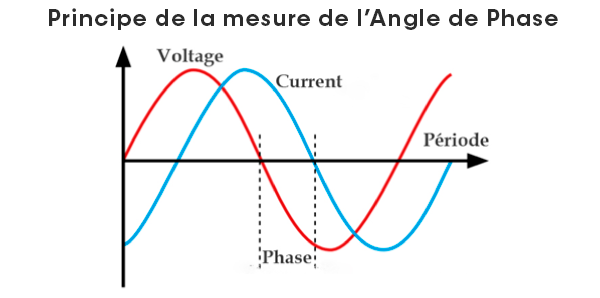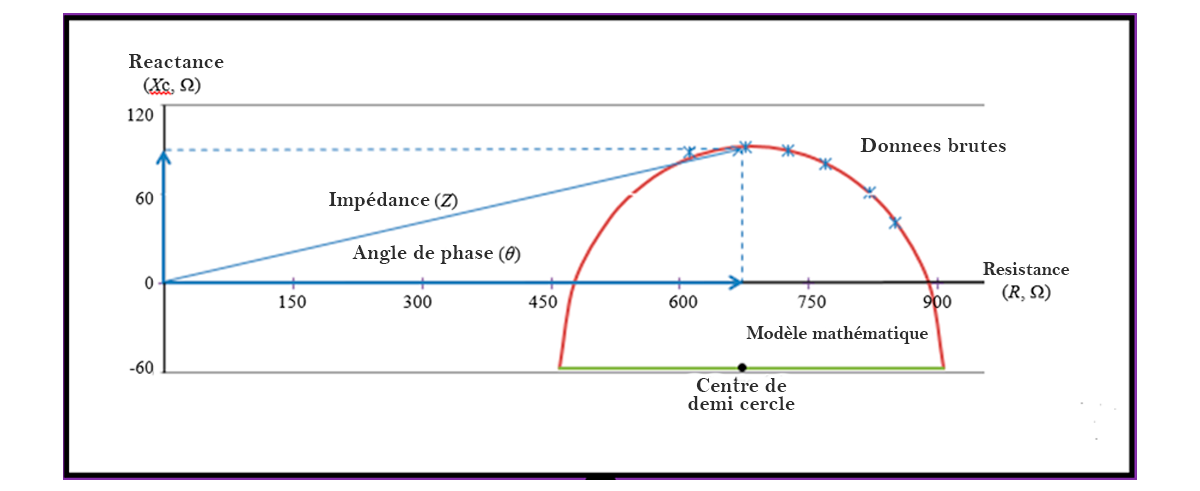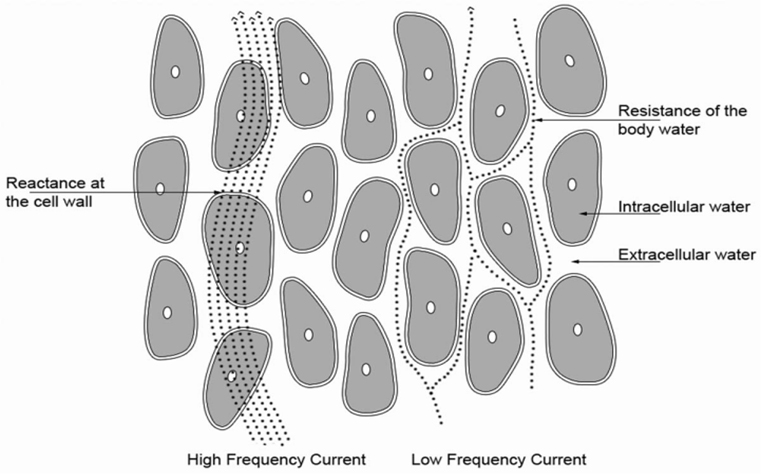In addition to body composition, bioimpedance analysis provides raw bioelectric values, including phase angle and impedance ratio, which are very useful in the day-to-day practice of healthcare professionals.
The phase angle (PhA) is a raw bioelectric value measured by bioimpedance analysis devices in two ways:


Figure 1 : Determination of phase angle by direct measurement (A) or from resistance and reactance (B). Période : Period ; Impédance : impedance; Angle de phase: phase angle; Données brutes ; raw data ; Modèle mathématique : mathematical model ; Centre de demi-cercle : half circle’s center.
The resistance R is related to the tissue hydration, while the reactance Xc is linked to the integrity of the cell membrane, and these two parameters form the impedance Z. As a result, the value of PhA will be altered by physiological and pathological processes that can change the state of hydration and/or the integrity of the cell membrane. (1). More specifically, high hydration values will be associated with a decrease in resistance and high reactance is related to excellent membrane integrity, which will be represented by a high PhA value. On the opposite, when hydration decreases and/or cellular integrity is altered, PhA value decreases and can reach critical values, particularly in chronic pathologies.
Indeed, inflammation, chronic pathology, malnutrition or an unbalanced lifestyle can alter the electrical properties of tissues and, as a result, cause a decrease in the phase angle (2). On the contrary, a higher PhA value suggests a high body cell mass with a large quantity of intact cell membranes, which is associated with an excellent health status (3).
From a physiological point of view, PhA is dependent on sex, age, body mass index, nutritional status and the presence of pathological processes influencing hydration, nutrition or tissue conformation. (1). For example:
In addition, PhA can be used as a prognostic biomarker of body composition in healthy adults (4) and cardiovascular risk in several populations (5–7). It is also used as a prognostic biomarker of survival in many chronic diseases:
In healthy subjects and athletes, it has also been used as a prognostic biomarker of body cell mass (28), of muscle power (34) and strength (35), to evaluate the body composition of young athletes (36) or to measure sport performance (37).
In conclusion, the PhA is an interesting paramter for monitoring the health status of people over time, whether they are healthy or with a chronic pathology, but it is still necessary to know the reference values for the PhA. From the population data published by Bosy-Westphal et al. (38), reference values can be obtained listed in the tables below:
Men
| IMC 18,5-25 | Lower limit | Vulnerability state | Normal values |
|---|---|---|---|
| 18-29 ans | 6,05 | 6,05 - 6,86 | 6,86 - 8,30 |
| 30-59 ans | 5,73 | 5,37 - 6,63 | 6,63 - 8,03 |
| ≥ 60 ans | 4,30 | 4,30 - 5,53 | 5,53 - 7,17 |
| IMC 25-30 | Lower limit | Vulnerability state | Normal values |
|---|---|---|---|
| 18-29 ans | 6,32 | 6,32 - 7,08 | 7,08 - 8,48 |
| 30-59 ans | 5,94 | 5,94 - 6,92 | 6,92 - 8,30 |
| ≥ 60 ans | 4,77 | 4,77 - 5,86 | 5,86 - 7,36 |
| IMC >30 | Lower limit | Vulnerability state | Normal values |
|---|---|---|---|
| 18-29 ans | 6,07 | 6,07 - 7,01 | 7,01 - 8,43 |
| 30-59 ans | 6,19 | 6,19 - 6,91 | 6,91 - 8,35 |
| ≥ 60 ans | 4,82 | 4,82 - 5,87 | 5,87 - 7,39 |
Women
| IMC 18,5-25 | Lower limit | Vulnerability state | Normal values |
|---|---|---|---|
| 18-29 ans | 4,73 | 4,73 - 5,80 | 5,80 - 7,16 |
| 30-59 ans | 5,14 | 5,14 - 5,96 | 5,96 - 7,30 |
| ≥ 60 ans | 4,23 | 4,23 - 5,28 | 5,28 - 6,84 |
| IMC 25-30 | Lower limit | Vulnerability state | Normal values |
|---|---|---|---|
| 18-29 ans | 5,33 | 5,33 - 6,03 | 6,03 - 7,39 |
| 30-59 ans | 5,29 | 5,29 - 6,12 | 6,12 - 7,46 |
| ≥ 60 ans | 4,47 | 4,47 - 5,43 | 5,43 - 6,87 |
| IMC >30 | Lower limit | Vulnerability state | Normal values |
|---|---|---|---|
| 18-29 ans | 5,41 | 5,41 - 6,12 | 6,12 - 7,48 |
| 30-59 ans | 5,45 | 5,45 - 6,21 | 6,21 - 7,55 |
| ≥ 60 ans | 4,51 | 4,51 - 5,45 | 5,45 - 6,91 |
The impedance ratio is defined as the ratio of the impedance measured at 200 kHz (Z200) to the one measured at 5 kHz (Z5). These frequencies were chosen because of the particular characteristics of the cell membrane. Currents with frequencies below 7 kHz are not capable of crossing the cell membrane and therefore of penetrating the intracellular space, so these currents are only sensitive to the composition of the extracellular compartment. On the opposite, at 200 kHz, the current is able to cross the cell membrane and will therefore be sensitive to the composition of the body as a whole.

Figure 2 : Diagram showing current propagation as a function of frequency within the cell space (Extracted from Moonen et al. 2021, DOI: 10.1097/MCC.0000000000000840)
This specificity means that the impedance ratio is sensitive to the distribution of water between the intra- and extracellular compartment, particularly in situation like inflammation. Inflammation is associated with a degradation of the cell membrane, resulting in a transfer of intracellular water to the interstitial space, which will modify the impedance at 200 and 5 kHz. More precisely, as the cell is less hydrated, the impedance at 200 kHz will increase, whereas as the extracellular space is more hydrated, the impedance at 5 kHz will decrease. Mathematically, the impedance ratio will therefore be higher when the individual is in an inflammatory state, which has been verified by the positive correlation between this parameter and CRP, a biomarker of inflammation. (39).
There are currently no published reference values for this parameter in the scientific literature, but empirically it seems that above 0.80 for men and 0.82 for women, there is a low-grade inflammatory state in the individual. If the inflammatory state worsens, the impedance ratio will increase, while conversely, if the inflammation subsides, the impedance ratio will decrease. Generally, the normal values are:
Interestingly, there is a significant inverse relationship between phase angle and impedance ratio, so when an individual is in good health, their phase angle will be high and their impedance ratio low. On the opposite, when an individual's health status deteriorates, the value of the phase angle will decrease and that of the impedance ratio will increase, generally caused by an increase in oxidative stress and inflammation. Conversely, when the patient's health status improves, the phase angle and impedance ratio will return to their normal values. They are therefore two parameters of interest for monitoring an individual's health status.
Phase angle and impedance ratio are two raw bioimpedancemetry values linked to membrane integrity and inflammatory state, respectively. Their main benefit is therefore that they can be used to monitor the general health status of individuals quickly, economically, and non-invasively, both for prevention or management of chronic pathologies and for athletes during training.